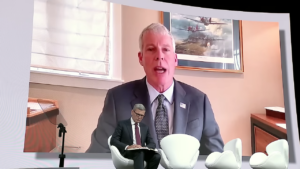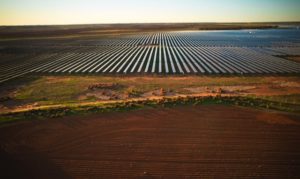The Victoria Labor state government has thrown down the gauntlet to the federal Coalition government and its climate-denying conservative wing, demanding three-year reviews as the price of its support for the proposed National Energy Guarantee.
The ACT government has also refined its condition of support, suggesting a review once the target gets close to the 26 per cent by 2030 target that the federal government is seeking to set in stone. It pretty much amounts to the same thing demanded by Victoria, given that the 26 per cent target will be met within a few years.
“We can still get this right – but only if Malcolm Turnbull stares down the climate-crazies in his party and puts a workable scheme on the table that doesn’t hurt local jobs and households,” energy minister Lily D’Ambrosio says in a statement.
The demands of Victoria and ACT – which reflect their long expressed concern about the inadequacies of the NEG – are designed to test both the Coalition and the big business claim that they are looking for a bipartisan solution, rather than simply legislating to block renewables in their tracks.
However, federal environment and energy minister Josh Frydenberg on Wednesday refused to budge, saying the Coalition was focused on prices rather than emissions, and even citing the risk of blackouts.
“Here’s an opportunity to avoid the blackouts, that will come, in Victoria if we don’t have a national energy guarantee,’ Frydenberg said. “There’s nothing stopping more renewables being built over time … that’s one of the myths being pedalled (by the Labor states).”
There problem is – that is exactly what is predicted by the Energy Security Board. Not only does it predict no reliability issues over the coming decade, it makes it quite clear there will be no new wind farms, no new solar farms, no new battery storage, no new anything.
Frydenberg fulminated against Labor, the Greens and Get Up, echoing The Australian which accused Victoria of “shameless, petty politics”. Groups such as the two big renewable big bodies, investors and engineers supported the Victoria and ACT position, but big business ducked for cover.
The Australian accused Victoria of “last-minute changes”, while embracing the Coalition government’s own last-minute change, a proposed NEG-plus that would provide government funding for new “dispatchble generation” that the fossil fuel industry hopes to mean a new coal plant.
If the current target is locked in for a decade, as the Coalition and big business wishes, then the official modelling shows the development of large-scale renewable energy will be brought to a halt.
D’Ambrosio says that for Victoria to sign up to the proposed NEG, the following conditions will need to be met:
- – Emissions reduction targets can be only allowed to increase over time and never go backwards;
- – Future targets will need to be set by regulation;
- – The targets will need to be set every three years, three years in advance;
- – Establishment of a transparent registry, with access by regulators and governments to ensure the NEG is working in the best interests of consumers.
The key is the three-year review of the target and the three-year notice of changes.
This goes to the core of the problem of the NEG, which under current policy seeks only a minimal reduction in emissions because most of the 26 per cent reduction target by 2030 will have been met nearly a decade earlier thanks to the wind and solar built for the renewable energy target.
The Coalition has sought to lock this target in for 10 years, even though the Energy Security Board’s own modelling said this would result in zero new construction in large-scale solar, large-scale wind, or even big batteries, from 2022.
That is a ridiculous position for the country to be in – even for the ESB to endorse – and is clearly a line too far for the states, most of whom will now withhold their agreement at the CoAG energy ministers meeting this Friday and await the next round of battles in the Coalition party room when parliament resumes next Tuesday.
That was to be followed by a phone call between energy minister Josh Frydenberg and the states, but it seems that the states have taken the obvious route and laid down their demands, and see what happens in the Coalition party room.
The three-year timeframe is considered crucial, making it easier for any Labor government, or even a Turnbull government free of the shackles of its “Monash Forum”, to increase ambition in the electricity sector, which can deliver low-cost abatement thanks to the plunge in costs of the renewable and storage technologies.
A decade-long investment freeze is unthinkable, and the Victorian position is backed by the likes of Origin Energy, and others, and will be supported by most other environmental groups, given the political realities.
 Will the business lobby back this initiative from Victoria? Big business says it is desperate for a NEG, but does it really want one that does nothing, or leaves things at the status quo like the table above, tweeted by the Climate and Energy College’s Simon Holmes à Court?
Will the business lobby back this initiative from Victoria? Big business says it is desperate for a NEG, but does it really want one that does nothing, or leaves things at the status quo like the table above, tweeted by the Climate and Energy College’s Simon Holmes à Court?
The spokesman for one leading lobby group appeared stumped when asked about this by RenewEconomy.
“It has been calling for the NEG to be backed by the states in the name of “certainty”, but certainty for business just may be no change for 10 years. If that is the case, then their position is a disgrace.”
Frydenberg has offered a “review” in 2024, at the same time as suggesting that any “quick changes” would not be acceptable, so the proposal amounted to very little.
The ACT has proposed a review once electricity emissions get to 24 per cent, which according to the ESB and other modelling will be in 2020. A review then, with an increased target, will ensure that investment continues in new generation and storage, particularly with the state-based targets also adding to construction.
“My suggestion is that … the final design of the NEG includes a mechanism to initiate a review immediately should electricity sector emissions reach a 24 per cent reduction on 2005 levels,” ACT energy minister Shane Rattenbury (Greens) wrote in a letter sent to Frydenberg on Tuesday.
“I believe this is a position that can address concerns of some stakeholders and I am happy to discuss this with you further.”
The ACT Government also insists that its ambitious renewable electricity and emissions targets be “additional” to the national emissions reduction target for the electricity sector. “The current NEG design sets up an unfair situation where the ACT will have to pay for the inaction of other jurisdictions,” he said.
And Rattenbury also asked for information on the so-called “NEG-Plus”, the rumoured proposal that the Coalition would offer the backbench an additional measure, which could include funding for a new coal-fired power station.
The three-year time frame is considered crucial, making it easier for any Labor government, or even a Turnbull government free of the shackles of its Monash Forum, to increase ambition in the electricity sector, which can deliver low-cost abatement thanks to the plunge in costs of the renewable and storage technologies.
D’Ambrosio says that Turnbull needs to back “real investment in clean energy, real jobs in the renewable industry and real action on climate change.”
She says the conditions will ensure the Victorian Renewable Energy Target – and the thousands of local jobs it supports – are protected.
- The need for a transparent registry is also considered important, given the hidden nature of much of the contracting in the energy industry, which would be reinforced by a NEG – most likely at the cost of prices because of the complexity of the policy.
- Frydenberg defended the lack of transparency, saying it would be accessible to regulators.
- “While the Labor party is talking about emissions, we’re focusing on prices,” Frydenberg says. The Coalition has been promoting the $550 reduction in bills, but most of this ($400) comes from the renewable energy target it tried to kill.
The Energy Security Board says the NEG will only be responsible for $150 of these price falls, and not for a few years, but even this is based on the spurious assumption that the NEG will deliver “certainty”.
But certainty will only come with agreement on emissions targets, and the ESB contradicted itself when it said that certainty would deliver savings in financing costs for new investment, but then went on to say that even with “certainty” there would be no new investment at current emissions targets.










